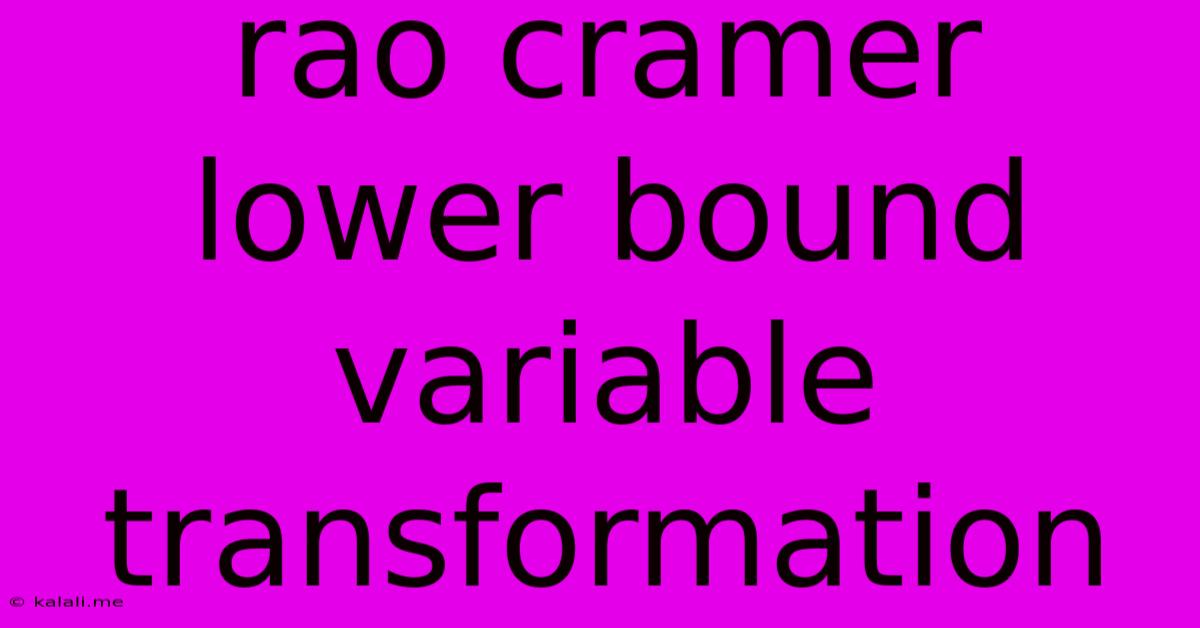Rao Cramer Lower Bound Variable Transformation
Kalali
Jun 07, 2025 · 3 min read

Table of Contents
Rao-Cramer Lower Bound and Variable Transformations: A Deep Dive
The Rao-Cramer Lower Bound (CRLB) is a fundamental concept in statistical inference, providing a lower bound on the variance of any unbiased estimator of a parameter. Understanding how variable transformations affect this bound is crucial for efficient statistical analysis and optimal estimator design. This article will delve into the intricacies of the CRLB and explore its behavior under different variable transformations. We'll examine how transformations impact the information matrix and ultimately the lower bound itself.
What is the Rao-Cramer Lower Bound?
In essence, the CRLB states that for an unbiased estimator θ̂ of a parameter θ, the variance of the estimator is always greater than or equal to the inverse of the Fisher information:
Var(θ̂) ≥ 1/I(θ)
where I(θ) is the Fisher information, a measure of the amount of information a random sample carries about the parameter θ. A higher Fisher information indicates more precise estimation, leading to a tighter lower bound on the variance. The Fisher information is often calculated as the expectation of the square of the score function (the derivative of the log-likelihood function).
The Role of the Score Function and Likelihood Function
The score function, denoted as U(θ;x) where x is the observed data, plays a central role in calculating the Fisher information. It represents the sensitivity of the log-likelihood function to changes in the parameter θ. The Fisher information, I(θ), is then computed as the expectation of the square of the score function or, equivalently, as the negative expectation of the second derivative of the log-likelihood function:
I(θ) = E[U(θ;x)²] = -E[∂²log L(θ;x)/∂θ²]
The likelihood function, L(θ;x), represents the probability of observing the data x given a specific value of the parameter θ. Accurate calculation of the likelihood function is essential for correct Fisher information estimation.
Impact of Variable Transformations on the CRLB
Now, let's consider the effect of a transformation on the CRLB. Suppose we have a transformation g(θ) = η. How does this affect the lower bound on the variance of the estimator of η?
The key insight lies in understanding how the Fisher information transforms under this change of variables. It doesn't simply transform linearly. Instead, it's modified by the Jacobian of the transformation. Specifically, the Fisher information for the transformed parameter η is given by:
I(η) = I(θ) / (g'(θ))²
where g'(θ) is the derivative of the transformation function g(θ) with respect to θ.
This shows that the Fisher information for the transformed parameter η is inversely proportional to the square of the derivative of the transformation function. Consequently, the CRLB for η will be:
Var(η̂) ≥ 1/I(η) = (g'(θ))²/I(θ)
Implications and Examples
This has significant implications for estimator efficiency. If the transformation involves a large derivative (g'(θ)), the CRLB for the transformed parameter η will be larger than the CRLB for the original parameter θ. Conversely, a small derivative will lead to a tighter bound.
For example:
- Linear transformations: Linear transformations generally don't significantly alter the CRLB, particularly when the transformation is a simple scaling or shifting.
- Nonlinear transformations: Nonlinear transformations can significantly impact the CRLB, potentially leading to a much wider or tighter bound depending on the specific nature of the transformation and the value of θ. Careful consideration is necessary.
Conclusion
Understanding how variable transformations affect the Rao-Cramer Lower Bound is essential for efficient statistical inference. The transformation of the Fisher information, which directly influences the CRLB, isn't trivial and depends on the Jacobian of the transformation. Analyzing the effect of a transformation on the derivative of the transformation function helps anticipate its effect on the CRLB. Therefore, choosing appropriate transformations requires careful consideration of their impact on the Fisher information and subsequently on the precision of parameter estimation. It highlights the importance of selecting transformations that minimize the variance of the estimator while ensuring accurate parameter estimation.
Latest Posts
Latest Posts
-
Robots Txt In Wordpress Stuck On Disallow
Jun 08, 2025
-
Are You Still Up For Meaning
Jun 08, 2025
-
Who Killed Stephen In The Bible
Jun 08, 2025
-
How Do You Say Silly In Spanish
Jun 08, 2025
-
How To Fix Ripped Drywall Paper
Jun 08, 2025
Related Post
Thank you for visiting our website which covers about Rao Cramer Lower Bound Variable Transformation . We hope the information provided has been useful to you. Feel free to contact us if you have any questions or need further assistance. See you next time and don't miss to bookmark.